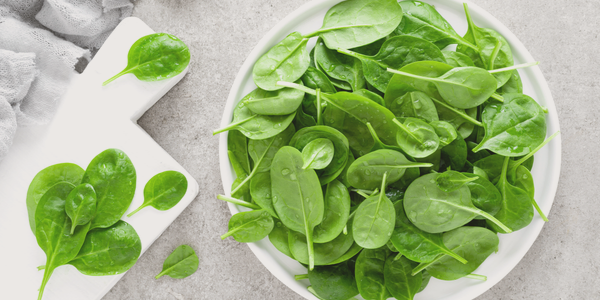
While spinach may not actually give you immediate Popeye strength, there are many health reasons to add spinach to your diet. On top of spinach's health benefits, it is a versatile green that can be used in many ways beyond a traditional green salad.
Wondering why spinach is good for you and looking for tasty and easy ways to add this leafy green to your diet? Discover all spinach has to offer from its nutritional benefits and surprisingly delicious ways to use it.
Spinach Nutrition
What makes spinach one of the top healthy green foods? It packs a nutritional punch for a minimal amount of calories making it a top choice as a nutrition superstar by many health experts.
Raw Spinach Nutrition
A cup of raw spinach only has about 7 calories but is rich in antioxidants, vitamins, and minerals. In fact, a cup of raw spinach provides the following:
• 56% Daily Value (DV) vitamin A (as beta carotene)
• 14% DV vitamin C
• 3% DV calcium
• 4.5% DV iron
• 5% DV potassium
• 3% DV fiber
Cooked Spinach Nutrition
When spinach is cooked, it wilts down. Therefore, more is able to fit into a measurement like a cup, so the nutrition facts for cooked spinach are slightly different. A cup of spinach is still low in calories - with only about 40 calories - and provides the following:
• 377% DV vitamin A (as beta carotene)
• 29% DV vitamin C
• 19% DV calcium
• 36% DV iron
• 24% DV potassium
• 17% DV fiber
Can You Eat Too Much Spinach?
Both raw and cooked spinach are considered healthy foods, and most people do not need to worry about eating too much spinach. In fact, most people should focus on how they can get more spinach in their diet.
However, the two groups of people who may warrant caution from drastically increasing their intake of spinach are those on blood-thinning medications and those with kidney health concerns. As spinach is high in vitamin K, which helps clot the blood, those on blood thinners should avoid drastically changing their intake of vitamin K without consulting a doctor.
Spinach is high in oxalates, and those at risk for kidney stones may benefit from following a diet low in oxalates. Oxalates can also inhibit the absorption of some minerals. Most people do not need to worry about the drawback of oxalates from foods like spinach, as these foods provide so many other nutrients.
If you are wondering if you should follow a low oxalate diet, ask your doctor or dietitian.
5 Benefits of Spinach
Because spinach has so many nutrients, the health benefits it provides are numerous. Here are some of the top things spinach is good for and reasons to add to your diet.
Heart and Blood Health
Spinach provides minerals potassium, magnesium, and calcium. These minerals play an important role in maintaining healthy blood pressure. The iron and vitamin C levels in spinach can also help protect against anemia, a condition where blood cells do not transport enough oxygen in the body.
Plant sources of iron are not absorbed as well as animal sources. Vitamin C is needed to help increase the absorption of iron, and spinach provides both of these nutrients.
Spinach also provides another blood-building nutrient, vitamin B9 or known as folate. Folate works with vitamin B6 and B12 to lower homocysteine levels in the blood. High levels of homocysteine can increase the risk of cardiovascular/heart disease.
Eye Protection
Spinach, like other fruits and vegetables, is a good source of specific eye-protecting antioxidants lutein and zeaxanthin. In fact, some research suggests eating spinach as part of your regular diet can help protect against age-related macular degeneration.
Specifically, three servings of spinach per week may reduce the risk of developing macular degeneration by up to 43 percent according to Anne M. Hanneken, Ophthalmologist in a Scripps.org article.
Note: in order to get the most lutein from spinach, raw spinach is the highest. Chopping or blending raw spinach can further increase the amount of lutein absorbed from spinach.
According to Harvard Health, lutein levels dropped by 40% after only four minutes of boiling, and by 90% after 90 minutes, while levels decreased by more than 60% after just two minutes of frying. Spinach lost about 50% of its lutein after four minutes of steaming.
Ample Antioxidant Source
Arguably one of spinach's (and other leafy greens) most well-known health claims to fame is being a great source of antioxidants. Besides eye-protecting lutein and zeaxanthin, spinach is a good source of chlorophyll which gives it the bright green color.
Chlorophyll, along with other antioxidants, can protect cells from damage caused by free radicals. which could include damage from carcinogens. This means eating a diet high in antioxidant sources, like spinach, could help lower the risk for diseases such as cancer.
Supports Bones Health
When you think of bone-building foods, spinach may not be at the top of your list. However, it should be included! Spinach is high in vitamin K, which not only helps clot the blood but is also required for the making of proteins needed for bone metabolism.
Some studies suggest higher vitamin K intakes with higher bone mineral density and/or lower hip fracture incidence. Leafy greens, like spinach, are one of the highest dietary sources of vitamin K.
Supplies Skin & Hair Nutrients
Surprise! Besides heart, eye, and bone health, spinach is also a good food for skin and hair health. Spinach provides both vitamin A and C which are necessary for healthy skin and hair.
Vitamin A is needed for sebum production which is necessary for hair to look shiny and healthy, as sebum lubricates hair follicles. Vitamin A is also a key component in many skin creams, as it can help maintain skin integrity and promote skin healing.
Vitamin C is a building block for the body to make collagen. Collagen is needed for strong bones as well as to provide a firm layer underneath the skin.
5 Ways to Use Spinach That Everyone Will Love
Spinach recipes go beyond a typical spinach-based salad. Here are some ways to use spinach, whether highlighted or hidden, that everyone will appreciate!
Elevate Egg Dishes
Whether scrambling eggs, making an omelet, or a frittata, spinach can easily be added to egg recipes.
Simply chop up spinach leaves and add them to the pan while cooking eggs. Add in other veggies as desired to make an even more colorful and tasty egg creation.
Add to Soups and Sandwiches
Spinach can be added to any savory sandwich as an easy way to get it in for lunch (or any time of day).
Similarly, a handful (or more) of spinach can be added to any homemade soups or stews! Simply chop up the spinach and add to the pot towards the end of simmer time.
Sneak in Smoothies
Adding spinach to smoothies can be a helpful way to get in spinach for those that are convinced they do not want to eat spinach!
Blending in a handful of spinach with other smoothie ingredients can minimize the taste and appearance of spinach once mixed. But, the health benefits are still there for all to enjoy.
Tuck into Dips and Sauces
Spinach artichoke dip is a famous spinach-based dish, but it can be high in calories and fat.
If you are looking for a healthier spinach dip, try BistroMD's Indian creamed spinach. This unique dip is an innovative combo of two delicious recipes, including spinach artichoke dip and saag paneer. It is delicious paired with bread, naan, or your favorite chips.
Spinach can also be highlighted as a beautiful green sauce for pasta with an easy spinach sauce that can be made with just olive oil, garlic, spinach, dairy or non-dairy cream, and nutritional yeast. Spinach can also be subbed either partly or fully for many pesto recipes.
Add to Anything but Basic Salads
Looking to change up a ho-hum spinach salad? Try adding spinach to any whole grain or bean-based salad. These salads all include spinach but are packed with flavor and may win over those who are not crazy about spinach-forward salads.
• White bean salad with spinach, garlic, and sundried tomatoes pairs yummy Mediterranean flavors and ingredients for a delicious salad that can be made in 20 minutes.
• Simple barley salad comes together in just 10 minutes with cooked barley, spinach, onion, slivered almonds, and garlic. It is a tasty way to enjoy a whole grain-based salad as a delicious, easy side dish.
• Mediterranean rice salad is another whole grain salad with spinach based on brown rice and paired with tomatoes, olives, feta cheese, cucumbers, and an easy homemade dressing.
Bottom Line: What Spinach Is Good For
Spinach is a vibrant leafy green that is rich in many vitamins, minerals, antioxidants, and fiber. It is naturally low in calories, fat, sugar, and sodium. This combination makes it a nutrient-dense food that, sadly, many Americans do not get enough of in their diet.
To name a few, spinach offers heart, eye, bone, skin, and hair health benefits by being a good source of magnesium, potassium, vitamin K, vitamin A, vitamin C, and a number of antioxidants. In addition, the fiber from spinach helps keep you feeling full and blood sugar levels balanced.
Besides a typical spinach salad, spinach can be used in many creative ways including in eggs, smoothies, soups, sandwiches, dips, and sauces. It can also be added to other salads that are not leafy greens based like ones that use beans or whole grains.
References:
Chopped, uncooked spinach offers more antioxidants. Harvard Health. Published April 1, 2019. https://www.health.harvard.edu/staying-healthy/chopped-uncooked-spinach-offers-more-antioxidants#:~:text=Spinach%20is%20one%20of%20the,the%20risk%20of%20macular%20degeneration.
Eat your spinach, save your vision? Scripps Health. Published June 15, 2018. https://www.scripps.org/news_items/3005-eat-your-spinach-save-your-vision#:~:text=A%20large%2C%2010%2Dyear%20clinical,risk%20of%20developing%20macular%20degeneration.
Folate (folic acid). Mayo Clinic. Published February 23, 2021. https://www.mayoclinic.org/drugs-supplements-folate/art-20364625.
Roberts JL, Moreau R. Functional properties of spinach (Spinacia oleracea L.) phytochemicals and bioactives. Food & Function. Published June 22, 2016. https://pubs.rsc.org/en/content/articlelanding/2016/fo/c6fo00051g/unauth.
Spinach, cooked. Nutritionix. https://www.nutritionix.com/food/spinach-cooked.
Spinach, Raw, 1 cup. Nutritionix. https://www.nutritionix.com/i/usda/spinach-raw-1-cup/513fceb575b8dbbc210016e1.
Szalay J. Spinach: Health benefits, Nutrition Facts (& Popeye). LiveScience. Published February 8, 2022. https://www.livescience.com/51324-spinach-nutrition.html.






